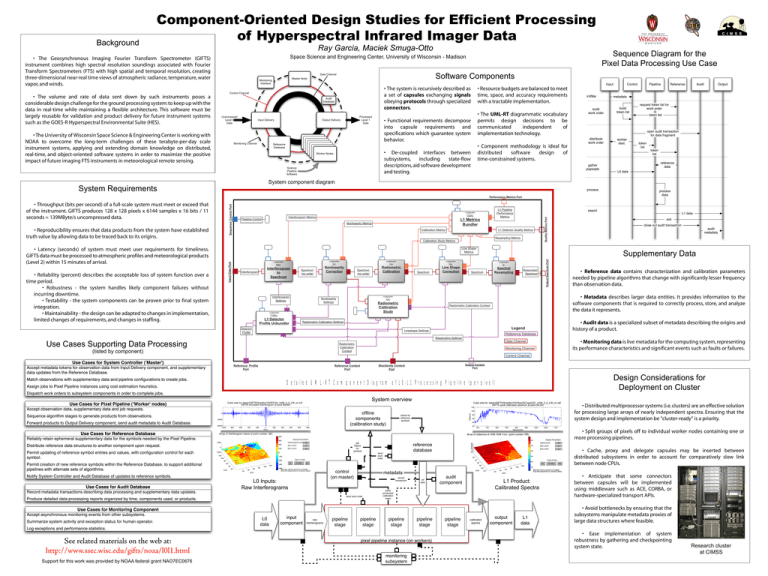Component-Oriented Design Studies for Efficient Processing of Hyperspectral Infrared Imager Data Background
advertisement

Background Component-Oriented Design Studies for Efficient Processing of Hyperspectral Infrared Imager Data Ray Garcia, Maciek Smuga-Otto • The Geosynchronous Imaging Fourier Transform Spectrometer (GIFTS) instrument combines high spectral resolution soundings associated with Fourier Transform Spectrometers (FTS) with high spatial and temporal resolution, creating three-dimensional near-real time views of atmospheric radiance, temperature, water vapor, and winds. • The volume and rate of data sent down by such instruments poses a considerable design challenge for the ground processing system: to keep up with the data in real-time while maintaining a flexible architecture. This software must be largely reusable for validation and product delivery for future instrument systems such as the GOES-R Hyperspectral Environmental Suite (HES). Sequence Diagram for the Pixel Data Processing Use Case Space Science and Engineering Center, University of Wisconsin - Madison Software Components Data Channel Master Node Monitoring Interface • The system is recursively described as a set of capsules exchanging signals obeying protocols through specialized connectors. Control Channel Audit Database Unprocessed Level 0 Data • The University of Wisconsin Space Science & Engineering Center is working with NOAA to overcome the long-term challenges of these terabyte-per-day scale instrument systems, applying and extending domain knowledge on distributed, real-time, and object-oriented software systems in order to maximize the positive impact of future imaging FTS instruments in meteorological remote sensing. Input Delivery Monitoring Channel Processed Level 1 Data Output Delivery • The UML-RT diagrammatic vocabulary permits design decisions to be communicated independent of implementation technology. • Functional requirements decompose into capsule requirements and specifications which guarantee system behavior. Worker Node Worker Node Worker Node Worker Node Worker Node Worker Node Worker Nodes Reference Database • Resource budgets are balanced to meet time, space, and accuracy requirements with a tractable implementation. • Component methodology is ideal for distributed software design of time-constrained systems. • De-coupled interfaces between subsystems, including state-flow descriptions, aid software development and testing. Science Pipeline Software System component diagram System Requirements l1qm: Interferogram Metrics Pipeline Control L1 Metrics Bundler Nonlinearity Metrics Calibration Metrics L1 Detector Quality Metrics Resampling Metrics Calibration Study Metrics • Reliability (percent) describes the acceptable loss of system function over a time period. • Robustness - the system handles likely component failures without incurring downtime. • Testability - the system components can be proven prior to final system integration. • Maintainability - the design can be adapted to changes in implementation, limited changes of requirements, and changes in staffing. Line Shape Metrics Input Data Port • Latency (seconds) of system must meet user requirements for timeliness. GIFTS data must be processed to atmospheric profiles and meteorological products (Level 2) within 15 minutes of arrival. Quality Metrics Port • Reproducibility ensures that data products from the system have established truth value by allowing data to be traced back to its origins. L1 Pipeline Performance Metrics «capsule» «capsule» nlc: «capsule» spc: Interferogram Interferogram to Spectrum Nonlinearity Correction Spectrum (no units) Interferogram Settings Spectrum (no units) Supplementary Data «capsule» rca: «capsule» ilsc: «capsule» sr: Radiometric Calibration Line Shape Correction Spectral Resampling Spectrum Spectrum Resampled Spectrum rcs: Radiometric Calibration Study «capsule» • Reference data contains characterization and calibration parameters needed by pipeline algorithms that change with significantly lesser frequency than observation data. • Metadata describes larger data entities. It provides information to the software components that is required to correctly process, store, and analyze the data it represents. «capsule» Nonlinearity Settings Output Spectrum Port • Throughput (bits per second) of a full-scale system must meet or exceed that of the instrument. GIFTS produces 128 x 128 pixels x 6144 samples x 16 bits / 11 seconds = 139MByte/s uncompressed data. Sequence Control Port Performance Metrics Port Radiometric Calibration Context l1dpu: L1 Detector Profile Unbundler Radiometric Calibration Settings Detector Profile Legend Lineshape Settings • Audit data is a specialized subset of metadata describing the origins and history of a product. Reference Database Resampling Settings Use Cases Supporting Data Processing Data Channel Radiometric Calibration Context (listed by component) Monitoring Channel • Monitoring data is live metadata for the computing system, representing its performance characteristics and significant events such as faults or failures. Control Channel Reference Profile Port Output Context Port Blackbody Context Port Reference Context Port Design Considerations for Deployment on Cluster � � � � ��� � �� � � �� � �� � � � � � � � � �� �� � � � � �� ��� � �� � �� � � � � � � �� � �� �� � ��� � ��� � � �� �� � �� System overview offline components (calibration study) • Distributed multiprocessor systems (i.e. clusters) are an effective solution for processing large arrays of nearly independent spectra. Ensuring that the system design and implementation be "cluster-ready" is a priority. values for reference symbols • Split groups of pixels off to individual worker nodes containing one or more processing pipelines. get tokens for symbols control (on master) L0 Inputs: Raw Interferograms See related materials on the web at: http://www.ssec.wisc.edu/gifts/noaa/l0l1.html Support for this work was provided by NOAA federal grant NAO7EC0676 input component raw interferograms pipeline stage send work order metadata record transaction send work order L0 data reference database pipeline stage ref data • Cache, proxy and delegate capsules may be inserted between distributed subsystems in order to account for comparatively slow link between node CPUs. audit component L1 Product: Calibrated Spectra partly processed calibration views pipeline stage pipeline stage pixel pipeline instance (on workers) monitoring subsystem pipeline stage calibrated spectra output component L1 data • Anticipate that some connectors between capsules will be implemented using middleware such as ACE, CORBA, or hardware-specialized transport APIs. • Avoid bottlenecks by ensuring that the subsystems manipulate metadata proxies of large data structures where feasible. • Ease implementation of system robustness by gathering and checkpointing system state. Research cluster at CIMSS




